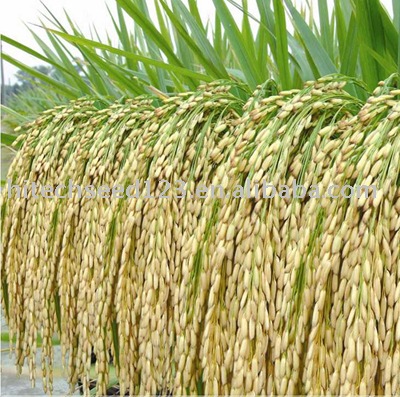
The Department of Agriculture conducts a program for that is concern to the rice planting and uplifting the lives of the Filipino farmers and it is called "Agri-Pinoy Program".
Why rice?
An
average Filipino diet is based on rice. It provides half of our calorie
requirements and one-third of our protein intake. Rice accounts for 20%
of food expenditures for average households, which increases to 30% for
households belonging to the bottom third of our society.
As a
durable crop that can be relied on to bring good harvest year in and
year out, rice is grown in some 3.2 million hectares of land, providing
livelihood to more than two million households engaged in rice-based
farming, along with millions of farm laborers, and tens of thousands of
merchants and traders.
Rice,
as a food staple, is an economic commodity. It is both a major
expenditure item and a source of income for many households. As food is
our most basic necessity, demand for rice cuts across all social
classes. Rural households also depend, in varying degrees, on the
various stages of rice production for livelihood.
Rice
also plays important macroeconomic and developmental roles. Movements in
the price of rice have a substantial bearing on overall inflation
rates, fuelling concern from policymakers on pricing and fiscal
stability. Because a large part of the population remains in
agriculture, growth in output and productivity are essential to spur
economic development.
Globally,
food supply is threatened by a growing demand to feed an increasing
population in the face of scarcity in land and water resources. Since a
majority of small Filipino farmers and rural households depend on food
farming for their own consumption and income, government support is
critical to encourage domestic production or self-sufficiency to address
poverty, food insecurity, and providing a key ingredient to economic
stability in the long term.
It is
towards these ends that the National Rice Program plays an important
role in the flagship food program of the administration of President
Benigno S. Aquino III.
What is the Agri-Pinoy Rice Program?
The Agri-Pinoy Rice Program is one of the banner components of the Department of Agriculture mainly concerned in rice farming and uplifting the lives of Filipino farmers.
Guided
by the principles of the Agrikulturang Pilipino (Agri-Pinoy) framework,
the National Rice Program integrates government initiatives and
interventions for the agriculture sector, namely: food security and
self-sufficiency, sustainable resource management, support services from
farm to table, and broad-based local partnerships.
The
Agri-Pinoy Rice Program plays a key role in the Food Staples Sufficiency
Program (FSSP), the central focus of the country's food security policy
from 2011 to 2016 and beyond.
With
the vision of a food-secure society where farmers enjoy a decent and
rising standards of living, the FSSP 2011-2016 aims to achieve
self-sufficiency in food staples. Self-sufficiency means satisfying
domestic requirements for food, seeds, processing, and feeds through
domestic production.
The
key target is to produce the country's domestic requirements by 2013.
Beyond 2013, the aim is to strengthen national resilience in staples
production.
The key strategies are concentrated in the following: (1) raising farmers' productivity and competitiveness, (2) enhancing economic incentives and enabling mechanisms, and (3) managing food staples consumption.
The key strategies are concentrated in the following: (1) raising farmers' productivity and competitiveness, (2) enhancing economic incentives and enabling mechanisms, and (3) managing food staples consumption.
To
carry out these objectives, various government interventions are
undertaken from the national to the local levels in the form of support
to rice production; irrigation; postharvest and other infrastructure
facilities; market development services; extension, education and
training services; and research and development.
A. Production support
- Production of Breeder Seeds of Inbred and Nucleus/Breeder Seeds of Hybrid Parentals
- Basic Breeder Seed Production
- Seed Production of varieties for climate change adaptation/mitigation; Including varieties that are submergence-tolerant, drought-tolerant/early maturing, saline-tolerant, and cool-elevated
- Upland Rice Production Development
- Establishment of Community Seed Banks; including rehabilitation and establishment, distribution of simple seed processing equipment; and locally adopted starter seeds
- Support to RIARC Development and Activation, including production and distribution of registered seeds, and purification and multiplication of traditional and locally adopted varieties
- Disaster Response like buffer seed stocking and provision of insurance coverage
- Establishment of pest outbreak control measures like bactericides, insecticides, fungicides, rodenticides, and light traps
- Cloud seeding operations on vulnerable regions
- Distribution of fertilizers for rationing
- Establishment of agro-meteorological (agro-met) stations per major rice district
- Establishment and maintenance of Multi-Purpose Bio-Organic Fertilizer Plants
- Conduct of pest and diseases surveillance/SEWS in clustered areas to determine and prevent pest occurrence; and strengthening of pest surveillance teams
- Establishment of community-based bio-control agent laboratories, including upgrading of technical capabilities of bio-control laboratories
- Promotion of nutrient management tools as aid in formulation of SSNM options and varieties
- Support to soil laboratories and establishment of mobile soil clinics
- Distribution of farm and fishery production-related machinery and equipment such as: Rice Drum Seeders, Rice Transplanters, Mini four-wheel drive tractors, Rice Hull Carbonizers, and Hand Tractors
B. Irrigation Development Services
- Support to activities of the National Irrigation Administration, an attached agency of the Department of Agriculture, in restoration, rehabilitation, and generation activities of irrigation systems and their service areas.
- Provision of Small Scale Irrigation Projects in rice cluster areas to ensure that major waterways are functional to achieve high irrigation efficiency
- Operating, monitoring, and evaluation of irrigable areas or service areas expanded through restoration, rehabilitation, and construction of Small Water Impounding Projects, Diversion Dams, and Small Farm Reservoirs
C. Other Infrastructure and Postharvest Development Services
D. Market Development Services
- Market Promotion and Development, consisting of the establishment of Seed Trading Centers and e-Trading centers, and holding of agri-business investment clinics, market matching, and trade fairs
- Generation, periodic updating and dissemination of regional rice statistics and market information such as inflow and outflow, demand and supply, palay and milled rice prices, basic rice statistics (effective rice area, area planted & harvested, production, yield per hectare, sufficiency), input suppliers, millers, etc., supply chain and cost structure analysis, price monitoring, and updating of cost structure, stakeholders directory, market profiles, and rice value-added products
- Establishing linkages with public and private financial institutions, NGOs, and agri-business entities
E. Extension Support, Education and Training Services
- Conduct of trainings and training-related events for farmers such as technology transfers, schools-on-the air, Farmers' Field Day, sustainable agriculture practices, Palay Check, Palayamanan, and other social mobilization activities
- Conduct of technology demonstrations (Techno-Demo) such as varietal TD, compact hybrid/cluster, community-based MRC, LSTD, abiotic stress environments, etc.
- Promotion and showcase of environment-friendly technologies adaptable to organic production
- Technology commercialization for ratooned rice, upland, submergence, and saline rice varieties
- Technology updating and re-tooling of agricultural extension workers (AEWs) and farmer technicians by conducting specialized trainings
- Provision of logistical support to LGU Extension Workers and para-technicians,
- Organization and strengthening of Irrigators Associations (IAs) and farmers' organizations by forming and mobilizing clusters and conducting technical briefings
- Engages in intensive information dissemination campaigns by distributing IEC materials such as newsletters, posters, brochures, handouts, flipcharts, billboards and streamers; print, radio and television campaigns; information caravans; schools-on-the-air, and other related activities.
F. Research and Development Services
- Adopts research and development activities on new rice technologies, such as researcher and farmer-managed adaptability trials for new hybrids and inbred certified seeds; screening, selection and commercialization of special rice varieties like organic and biotic-stress resistant; assessment and validation of soil fertility of rice clusters for organic rice production;
- Promotion and adoption of technology on controlled irrigation, irrigated and rain-fed rice systems
- Collection of germplasm for indigenous vegetables, rootcrops, and native staples in support to Integrated Farming Systems
" Conduct of climate change mitigation and verification studies - Research and provision of assistance on the commercialization of organic fertilizers
- Upgrading of research facilities
- Support to the research and development programs of the Philippine Rice Research Institute (PhilRice)
Further,
the Agri-Pinoy Rice Program develops, maintains, implements, monitors,
and evaluates plans and policies that affect over-all rice production,
farmers' welfare, consumer interests, and climate or environmental
concerns.
Specific policy-oriented activities of the Agri-Pinoy Rice Program include:
Specific policy-oriented activities of the Agri-Pinoy Rice Program include:
Policy review and technical updates;
- Generation of nationwide rice statistics from national surveys and other statistical activities; planning and monitoring of program activities and interventions;
- Conduct of quarterly program reviews from provincial and regional data;
- Holding of coordination meetings with stakeholders;
- Conduct of regular operational and program monitoring and evaluation activities to determine program implementation and delivery of services;
- Support to the establishment of a National Rice Council;
- And support to regional rice action teams.
 There are many different types of pesticides, each is meant to be effective against specific pests. The term "-cide" comes from the Latin word "to kill."
There are many different types of pesticides, each is meant to be effective against specific pests. The term "-cide" comes from the Latin word "to kill."


